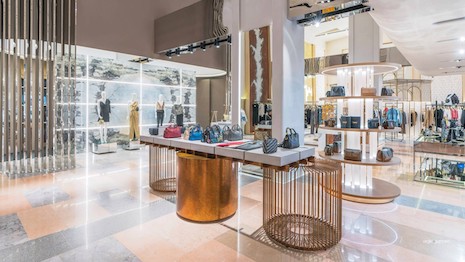By Fabio Cattaneo
In the last few years, the fashion sector has seen a notable evolution of licensing agreements due to an increasingly competitive context and growing globalization as well as the rise of new markets and the tarnishing of others.
The licensing agreement in fashion sector is a strategic tool for the growth of fashion houses. The most common license used is the trademark license.
Through the license agreement the licensor, who is the owner of the trademark rights, grants on a temporary basis and upon payment of a royalty to the licensee the right to use the object of the contract.
The licensing agreement has the advantage of being extremely flexible and tailorable in relation to the purposes that the parties intend to achieve.
Licensing is a commercial tool for fashion houses to reach goals such as revenue growth, product SKU ramp-up and commercial market penetration.
Different types of licenses can be distinguished: merchandising, opportunistic and strategic licenses.
These licenses can, in turn, be structured in production licenses, commercial distributions licenses or both licenses.
In merchandising agreements usually, the licensor has a certain notoriety in reference to certain product categories and there is a distance between both productive and distributive between the categories of core business and the new product categories of the license.
In this type of license, the extension of the product categories is considered from the licensor as an opportunity to expand the revenue and the range of products, that the company would not be able to produce on its own.
For the licensee it offers the possibility of expanding its own production and distribution know-how, without having to invest in new brands.
The opportunistic licenses are frequently used when there is greater integration between the two partners, with respect to the merchandising.
For example, when the product categories of the license constitute the “natural” extension of the licensor’s core business, such as the license of sportswear, childrenswear or underwear when the licensor produces shoes.
This system of licenses is widespread in the fashion industry, because it allows an expansion of the merchandise range to products near to the core business, limiting the investment costs for product development.
Strategic licenses are the most used tool for strategic positioning and enriching the attractiveness of the brand.
For example, through this kind of agreement in the perfume business the licensor participates in the choice of the essences and presentation of the packages.
The licensor also agrees with the licensee about the marketing policy for the licensed product on different channels, some of them chosen by the licensor, others under the commercial influence of the licensee.
These agreements are widely used in sectors such as perfumes and cosmetics, which have different dynamics and production logics from those of apparel and need specialized structures.
Evolution of licensing
This is not the place for an in-depth analysis of all the legal characteristics of the license agreements of the different types mentioned above. However, some of the evolutionary traits more present in the most recent licensing can be highlighted.
For one, the ideal characteristics of the licensee for the licensor have changed.
Bargaining power was initially very biased in favor of the licensor, which was strong in its know-how and in awareness of its trademark, often imposed exclusivity on the licensee and a production and/or commercial strategy rigidly predetermined by licensor.
Recently, there has been a reappropriation by all the big brands of a part of the commercial and distribution management through mono-brand shops, outlets and shopping mall. This has rebought distribution management under the direct control of the licensor.
On the other hand, the increasing product skills developed by the licensees have ensured that many of these licensees do not operate currently in exclusivity for a brand, but they produce for potentially competing brands, with a greater contractual balance.
This evolution of licensing is confirmed by some conditions now present in all major licensing agreements.
Firstly, the duration of the contract has become longer than in the past.
Secondly, it assists with increasing frequency the provision of a pre-emption right that licensor grants to the licensee on other lines related to the licensed brand.
The increased bargaining power of the licensee is counterbalanced by the minimum turnover clauses that the licensor usually asks as an essential condition for the maintenance, or failing, to withdraw from the license.
Finally, some key reasons why more companies currently choose a partnership with a licensee are the production capacity, punctuality and high-quality level of the product that the latter can guarantee.
Above all, there is the possibility that the license relationship can create a real strategic partnership to consolidate the market position and win against the competition.
IN AN ULTRA-COMPETITIVE scenario such as the current one, licensing has changed from a strategic tool for growth of the brand to a defense tool of the market segment conquered by the brand.
The opinions expressed in this column are purely the author’s.
Fabio Cattaneo is a Milan-based senior lawyer at Studio ACBC Law, expert in legal advice for foreign investors who want to invest in Italy and the luxury sector. Reach him at fabio.cattaneo@acbc-law.com.
{"ct":"sSUGQJooyJXhqWn+MvoNolrmkxqVGYCSASic9hWvHtia5WceoZQAb9a2QXGEGsZEs7tnS9rjX9L5GulgexcGhbJUHDtut+aSsW2WD6IOw8res+uVlBMwnvZST+wdhn0+97VTilK6nhF8sMSlbs\/mmvr9Ej6UurGBlUIms0iVkpp1CHvW0SMPRRXH9S7ZwmZR7kumLta7E\/5qr4Xw5Gcra4sBHbuVdp9bzZcCkdFvW+0hAlCWdm1SX3h77Y0SMEpORua6s1VgmpdDcZyCWULWRn59A+ttbwgNyJJGxOE6D1Vg8VXRE2ovjI+hV\/Mz7whwkOoM067XxG5\/YimasPPFrhLry3L7pJlD1+7QB5J276a9LSZBjrB0cxMiV4wJ1Q762pbx2E7JbfVcgfKqpAJQq2hEj633wByjeLTho1lExpLOVl\/03M9ZHR6vkHBvfBfhOnUN29rBtkLbk7O8EyvaekyP1PppZqpqmYF6XJHQUQgIGHCPJkypFcPjrr1wjhy+nTT9qcvtnuKtshbW90ZRGBpc19c\/g6z90Oz5WpIRFXaRvT\/BmM4vC1ANQ0+KIWDQbRf+QseZ4bX8eYBGJ3N5MwqlxPSeOmh8wBDlyTD81ljCQ8XctBgjp53s8bHhdlBToF\/xf6J6xW0sw21k6vAeQhfdhNFUuwrASw\/21O\/glKAdjpLJF9CxsWNfAhYwR4NioB\/uaH3Hddpdpa3szfd\/DTkc8blhU4FLoM\/xSFvr7kJbH+nN1\/TFXyvR7KgZbytKqeHFOrWC0azymtlfrvCDsCinQnWwFPxBsQxbUHrRRfURqdrgnkhNMDH1ByxTH2tIrfUOwCGQO31GvQ0BZ\/ALL9KLAWc+ORgmHPsBKfe4R2gkjOSnkWa\/RmCP2GeVsMtZh96GyzJrXme3Hu0WMlq\/8RbYnyytyt+hVCAAPxJh25TE8tIKvu8qcX0OyIMbyt6hZx9rMHSaQuzoWgHgK2AhdoK41Mr+E0ijRkK1\/Jda7Ec\/Pknfzz2wZXGijKvNsmjabwS5TzcFEj33LY3AAicIqJYmggb5MAt6U2y\/pZBgdzLQnoauz93OICqXMZmJi2ZVaL9Bbot2H6wEJK46YopwEKeLt9JGRB3wjDe9GPUrBWOMpNrzxzLMilK3IWWvkxMftAYgK52UxGD09luiZH4hriKbjKZbs\/4v\/LuWQHTH8LXxrgN85UGoQbBm8xO\/2KmwXcM7YOdsMLBrw4aQuIa5gimG1Ktt+M4GrxFv9mlRQa7ZB91vdxvbak42bxmGPTUbHQV2WnH5uNCgvR7G2apwaao9WCjNSXN7h1+oiprn0RUs3tl\/MmjCvuztL9jeKsfF45jpPJpdi+5\/CHnIdAFkWMrtAXOj0Gar+LjLdEC0mY0\/kIf4a2FQhw4yGtTQxpMj2UW11FKH4KM+5\/n9Zrbmzo1JpVi7\/jB2Bp2vy6xKkRr5KLjKxuwjAt9D4cQXeTouVVfFUNlJ7+Q\/ms4ciN9q9TERHt9V6jABI6rR+j+\/z8xudsjq0hfJgEAXm78ctue4CoKRpLX0MDyb3vWWmeJLcrgcf9KEKZLKNKq\/0sDwqgNchaTVLQr1TjWcwoZy1BkyNAE5LOKtXIxrChyZk3kNMWm3oq\/ez2H7NOhCCz9nfg1zTdGW2KnrfeFIaVx+2lwBCImtrgHLoQplVt2JJRSmQOPIIyaGYNI8IdHeS2yBj9KmQIL2Al3mni\/9AUbnMm3ADWwUlZJAdDSdN8JdVp9oXMNYg7CFA1nnOQ0ag5ebvp52+R6kMv7lYerTyblRP8F7GlsVrizheaSIb602a\/IHVw+KxSkkiR3lsW4ZQkv0Jk+DHxHaH\/qfIji8FeVLKu99jnsXr9NtIle\/NDrNovN1rc5KXodn4vNTTQbDfpr5vzUR6y9K04Jkp+b2L5RLaH0UMLseZbmWpRxIsX1kqWvJrc\/W96pOVuLbIJcC0ch3K1yfmexfrBQODhtllDXp0RkmtZ9nRBw9oZ7qgFD2\/WKoCbCnY5d8e8gU0U4d5YnAs4wgJXPUT5XcO5RNs54e1N9+u9V1GBXG1Zsny9vkTf39\/O4rZ4Dxuuzs5zN0Ed1W7o2fU\/4cJST+HeiPiPZZH8wPNbULQt0JUzBu45NrrPYaG5pZMdFKSNROnA27wukDk76CF7li3GkhNN+9srLnLxFassrtjSM07fwyq5ajHSrKKnyDnQEr5ifdz0CFYvLKe\/Iuhd55BPTtLv8VtIk77d1o+mPJo32GrPkfdLazGb2AgyrwCacVo\/e2ZzQkJehoSMDnLe5ArYcVSacld2nXqT3zpP2mxyw1\/zrVqsGPgAH105cVIU1mWdyoTED\/1shJ5SrM7lnVpTXurisyjWL\/wNIspAbs\/d95PSSRkSSRY8KAeW+LpE\/9OGNdG6PO4OByntehQHYsqD9ypOEpanhkg9NIrwSTNryKuzkDrs3doZ7SRvqTSEjskdRsy1B2bLk1EdM6DnZXYANNN8n3p3b4K+Oe9dBDMgED1RX9Oap9OHsS6Kl\/k+XLCxun\/ju2vLbfvscrdwU3rE6yREYPozPD3gewq\/xDfPm6\/8eFZQ0a9fVJl5tYZoTWAcMb06O4o4BMrImlFnGQmF89zH7By9Ma\/PCj6I68JVL2fH2zm\/1bLSCCWHXRbg+RUDXgtShM46YakZYykXVxoG0c6QriK0n0bEB4ctywb5YKojfhTThdTF92vITe843RPCDezrjD9UnPbjobdn41jABoAM2o8N0WW4vneNG3b0gd0amY1KW3wRL6IJl2IzVJncRmFIvVqD0Vl1wCRpXWG8KwPGoFOfdeXjnryj9o4NLdkdcTdm7Xwg3C7bgZGpb3OG2Gsc43dxOBm0A35gGzbSnYMqsb10Mn3cITlB8kQ+Tb1ZYggFuIHu4xKYv+FBGaf6d96t68pNaYq5I0TmlOpO6gEnqa23xGLg9N1mShDgo\/4VKT1P\/wSkYScCqVrAnNtGALUH1zlRlSvcP932EeOvt3StMHwqZPbXzzad7wtSkXVElp4U9THvIm7KpG474GCTbu\/aPysClXDFHUTIwmfhI5bcTZW0gVeJN6QNEvjnt4\/WGMl69t9MnjtzhkUkoAywDa+5u079Ecv5EwuCX2XViOccFxn+sR83frIlwE4Ocm99OJaPHQfmMybC9pwxDZD8\/TlICdxFtt2oSTp\/hBhyzkuCooymxafJbSIYSsFvV8JV2S5YwGxy0o04xafsYm5oMjF0xV4O8vc5PJD+XZrGlNLSU6oQM9yoskm9hlCB58LhTr87iLVwfmW3zjuw\/ByFhQrTtpYmiZdA8f96PSPxs02Szyut4QS8KqEYq265NLMJcj\/AnG8mtsZ+KMb7QQLoTs7xnsbYaIrBA+uQKDdTKvJ0JJjoTiezXuRC2HGM3iRv415x3PhiJUzLbJRj8S4kxaR8\/tYEoT6fH5oQ8q4MVMeqXrIClWDE\/Q7FHoXSBnRzrUjrRjHBsoF11yK9hIVrr8XSqNTl50fIoJLmSPA8diK0NaMbYy4fSzQVVax\/uaZ1\/HwSQpoMgZhCQ5cnVrux1addSrx5gwgmdji3KLC\/9rWDEn7VlSQHW5z16DlT6KQbFicl1MDFCtWUaiEGy7tYcYCjXbqlF944H4\/0m\/+mKB8WIid5kSy9OPzDNjdZyzzd9mdHdfjaLwHUlpCS9wC1rpoJYnzLISCCXCvW67VywwU8p2y9F3PAQjSPeYBsGPGDKH0DF3foz9qwVjKcZVVqaCF20\/qd+SrnBbIr8pOv7CPprkhjkombcNxu7TPVQY\/hpnf9+1DHhPAPNfEwA1dyfZEtvTqE7vkNHAEKmUTb40eBUs8RVl\/slCtpHb63eRDO6wMWev0jOFyP4hQdimQcxvS36Cw550efny60Zs2m5k9R6v9bbX2Hjfu39txJYBLNIr4XMKP2LmZkdKSBg2ro91zz8HiNQHvF5iVDvgqyJXXYUlne0y7TaKYMECb4pUJIWLq14BAqby4i5kLkH1kbRe2qXSFzp9kPvfE2fXH4mCp4tKlu5qiT81q2e4WY96kb7Gi8xoyxyexnhpEEdzbB1KAJC9ZXMsxAYxAUOmE\/+\/i2iK9imclEUSXnfXoTK6wUlx2AXrmkgwULm5EiD46uQAQYeWsN4e9AkBDNSVUpQ7x3LSezvGCnlLGing1vLtmIOI7Tuj7KoGRDFqVdD6N9Fpqjvh2A8xkDTkhUQRLUlnTjIdS0eA9LHA61I\/Ukh5\/mvc0qofUyNG+SdAjZ2Vc7VzFCNvMVoWrTqklVDM95\/tYa9FdTTOPiLlQOswz8eCVoOVT3Z6QORIFhSdTOw6vvOeNi218R93qXAf2vVaVPhYCo19bv6A8rU+mkS0woAUv6abasKxnMj8hMu6btGiy256vIcZy6uv2OFyZkeTiaCMxoA5XmF9wOWkX1IwQLGI5L3djazI2jip+TBOMIIOexZqR06J5rBlZf+qDAwWSXVwMMDSyMicRUHWKCIeA9MFRGHXR2KH27IRMRHjtbP3zee5Hzk3S76+LqhwafzVs1uYGcbpvGhaO\/AVKQfhGxhNTzfaBPD37WAPGQx5mmgpxlXEGlhPrULVifDiSbv9pijJySlVLn7uhWGDNgg8uheaGy3jAlA14240C7ES4Lh2MP\/lAmmLIVVG6nhBKdAFhkDADYv59Kwysz5hjV7pkNZuDI4t+wz329Db\/fwTwte3I7ZpvlVWQNuND5pju\/PWJCbFTUdcmvo60KWQpY04C\/8H13ymsjVx7PMGUi1HvHy6apvmPegfkvSIds\/S+Vat\/IB8LncMdU01+QnX4ifi8CgsulBjk4bHjAsqhWxN0iduh3QX8Y4ZYMuc7fXGpSdJvSkxuHAq+fy+AyiwhVNKr9o6SnqXxEAQ5in4yYHnRD2R8AQvX6nK9JyJJuNmhP7KYkwyLF\/4G4B19LGLY5faPBjwtHZbLr6vmp9yybC3Fo\/BltP5i0zvVWv+gOcNTQZ3h2ZNt0Mt+E4JW2RiiG2B5rmpYVg0l5LqqDJZW3q1P5TLhhZCisQMbrWBnejiUjsuVG3EJGh+NCYqtavdujBaEIt\/AwgGq+nE5bqYEwBa6l6ugIiG3gNGUO88t7JKttlVbPT3qqJN8i8aGB15RLsxxStU4a1imHKQUd\/boFv\/bHxM1QTU2wZwQu1W54QGO0\/2YYgsKkGe+4HBl3ajE4ih1LGyyeFshKzvyg8vwcqrxm9+LZkF5KPcns2YMwJBNv0oF7qSKZUUdOJ+Di0Zk7ISzisRWT5z\/MQSErz6254LCokN8IbKUtRzgSfGI4myoU3XJX7f2iYw8oPvV3yXojkUMe6GoTtQkR7Q+ye5ouTOXY1D5CernPhM3VP1yfIeMJPQHAZ0UJb0nzil3N7cwXwlc1Isl4O+gpn+bZBhEjxoFO\/P2hi+aUq40DXya2TqvN4DsTKG7R3aM\/0uPqG4RdB93vmbIIo4LfitY2IlEszHyzn7RWcMiaWB8KBYybYCmo3e+HdS9kNd9GwSLIxuLZUs238eTzvDXejQF8kbZG9VE2UzGhP5k3yy1L3NjT7k8RPzUWGewf\/PT3DItR601aNNfcKQub5VKg4znn20BQ7ny1kapW+GqsAF5lA34IMRafStqgu+OFvFO3wImA3DrrVdK5tobNxK1oUnnQlCtY8I862aMDCZvwzdpBeAS36C2O8wkonDJHC7ONqxcemAmvLfIFCrhX0z3+uQvCBQdyE\/BEBdfvTIQz0P7mjxZLpkFxtOpjOIPcNpKTBcd2RvPzRt7H\/W8HyG0xQkyc2qwyuIfSZWuA+VUJdVTELkSB6uQmumqZXWGIGdcudJ7Mh4lCm2mnkWExKS5oVoLj3sUhOozN8DgtRig+VFNQvpoecKRgLFxpanoT4rgC\/ysRZPoSGaBMHJCFFNz5kpMnJ7st8MOTP4tfECnz8xgkXvjoBeGV\/NwP16nUonUu48eV4USv6v2qF8LX96wpfgX0gjncVcLbIgwhJa3U5wVU+zGA3gHBqIuI0rkaRxF1b8FJcCyibVTBG0Ah08F33sEUe4n8Q+\/sB17kzzJG0r9fTCkB6GCZ9Mwu9w2yY90TBxyChff+qJsxDJLjNj0JpCNJZImru4E3ZMJcRVq01eJVjrk5mCaMf9I63vrw6z2E6OstrKn3Xk3pcMIT7lWVo3fXipGmfMhzYo4lkIdBNOq\/K8QXdD8XTBUaUTozbXCDkAcXnjbEIJZs1znwKcL1gCdTA1WNgOoJl9l+z8Jru8tV9EFQAD+uu21e8Zh7ZzotszxTRuLwMV1eYZvIH3AGjYuOkfI\/OLJ18bRFZG7dT\/6XDz6grs5RjxPnE4wtcP1F2FKuZQ9dB+dIxHhY4B4Ba93IMpDwm5rG6WdrPiY\/SQrR1pj2fg2Zx3tNiBk0T6\/g8qFRF\/xIDHrRU8SWlFTGE9YDfly8jv\/mOj\/x019epTxfm+T4bpHQ5+KK6xFJtRxYIImZ1dyy12HFye7n4FWvS2SN5zvD4PHZXpfSElKAQIOGEhHj4RhHyYIDPvYXWbmfZjGnPFV9jmp6HG\/9mPXLmlosKVC1hac\/2zuSZnmplDmAT1Jibl+gsx921BF88qyRbNlszJAsCCT5kJz2uH0FEoYNcPz06voYUQVFoHX\/vlx4XvpJrwZTwjZpoReIJODStcNhUb\/r9RPMiKFSyMH92qhnuwC9K0mqQ7riWHlWIPFJi7TJLAPw6GHbKq6YYP66+OEIUk2J8NYJonDWqy1r\/YF8ESx6XV7hgrDaEWidsyOc+bIxMmhMoMgfyb8+s\/0khw9Jmsdgvm1QoNP\/RstBMKzONdtNeo8u3ojbiERDYmJGmbL35BK2ceiiTnHm8Yc0X3cbNc79pZ1H5NGk+rd2X502VLBU4+vNOPikdQpOVr51pghpRfPBrqY8h5iSiw0hg\/IsuN63pAfyAcFJdxnpn8D8k9I7e2\/Gto7MJ9nz0rTJfUNi16gJW3N2BkdTH\/JVAbRzP9EgR9U\/Xh1\/bkoqW7aBVoO7ZqzgtmLqFMhh4aTEskMSkYtycWjdi7kwcu\/uWVPXA7kMlrCnISS8Ed6fSTeCbM42HS6yPD28dS1iUeBx05YCNxevjf2QWi+FWJYnvQPwbGnGRL146NwinpzX6iaCt8Ej42Nqs2VQT7Ie32Sq\/x3gSWZ28K5mhMN9VpxiSvLqp\/sQAyC5zhpIBhauseKygvQNJxbwlUkbtqM0ztEDu4idmBSMuT0Pz8sqQ3\/CD7WaXo+hVxQsil83pK4E2dK2odDcwl32y+WAmR+uK7X4O27KNUyt0CRwoqNioIOOolO9mHdTvcMGpG66q9Y9Z3K\/onw8aOmjNf4zUiONKVApCvPNxF4vJNBy\/iMPKx14mMUOqFA23LJdlFs72YtbcQZ28zrnfXladUMN0GTHNcaZ0Ww5qjL0eBtrEcBsYRcDMSDdFFGDIkHKQh1duKDst0y2+EjoTLb4DEh9sDzneR8elzkmJPZzqOmR8JKf9r+yEWTAS4uMM7NJHbCQUhcbU5m6+bLb4EVn04Q3ezi1bwyfviDombngy3EAlbLJSvfvzBDBwNS30mTfS6b31NZV6hc6PRWfCBZHT\/yQWY3i+ATag7rLyocS1xPoUeVND5GR6Vvmni9kzXP+QD8lQd5fb2xA7vitSe5Ks7Ip8ztEynsK5PdYpspUhZDICr+dOuaDbGsKkO4MbD9J6NyQY7jlGqvn0AFfnycUj4KHjGVb7HVdLexl+wDN\/kyQfLW++aHgDMQ0ocTDJ8eLY4EwOlcjGJhZl\/ynCBLO+Q0z87gn9D1u+3o3mNe73a8N5lBRhYT6jiDUcEvcWTURO\/AEeu6T5N8hPW61Wz2ha0O4kfGGZSBfp2rLnunHn+6iKYhM8lEheUCZotvfr+UVZev0SZwanXO+vrFHnN0n5FbKNQam43zKasw78ZS1dF1hhgZRATiamTv\/Yl+PUmfyXmhQQfjZRK10My9B+p+doINGn0Fa\/mCc0ImwO1GngesI9S45kbFOV9AeQ\/lrd\/vS7mPGf6RLCBfiGmHWPXx2khPmtwbkVP2q3oAt9+kiTL8XLcDzjFQ9oovtlghNJNkfo4oEr3ivGlchP57PatDVmaKpXc9KWfWgUobrDVRy8tVT2W4Fff225fAzCbrr6CV5HbTZxdwHBagDyp1lXqqi6iSMNB55CIN8DC8iBtbKnfoWEVWTzmRNHiujFLH7qNPouRCvuik3qqMeuhXfuHZAX0QJ9UhN\/Na5wJZptClVpfUhVD9R0SPkrSDUgbN1Hc2TEkAxbqHhgSWE6B50Tj76oTin8V4hBFt3\/ZWWLQohzJwtt9p++uOFd7esP+IKHJgUlXkyCL1PAVPfQspMkHclGdLvj2GlAdJ+d3DlNU\/ThZIOs7h4h1BWDL9zFz3SWO+4cAwPKHvvqwadml+FgCpGigoYzH8BpFOKRGtxAXAgXMwOpX3d1FxnDjknnCbn89YJBPojlWqQySPLxh1jr4hnX3qfZsE3Eyba8p4Nz8xdrphbYm0Yqj3FKmtLf9rsVTZOvJP90y2dBcxf9wlQ==","iv":"176fcfcef3c62330d86e3a31f12fd2b6","s":"7127ee078841f1b6"}



























